
A cactus is a member of the plant family Cactaceae, a family comprising about 127 genera with some 1750 known species of the order Caryophyllales. The word "cactus" derives, through Latin, from the Ancient Greek κάκτος, kaktos, a name originally used by Theophrastus for a spiny plant whose identity is now not certain. Cacti occur in a wide range of shapes and sizes. Most cacti live in habitats subject to at least some drought. Many live in extremely dry environments, even being found in the Atacama Desert, one of the driest places on earth. Cacti show many adaptations to conserve water. Almost all cacti are succulents, meaning they have thickened, fleshy parts adapted to store water. Unlike many other succulents, the stem is the only part of most cacti where this vital process takes place. Most species of cacti have lost true leaves, retaining only spines, which are highly modified leaves. As well as defending against herbivores, spines help prevent water loss by reducing air flow close to the cactus and providing some shade. In the absence of leaves, enlarged stems carry out photosynthesis. Cacti are native to the Americas, ranging from Patagonia in the south to parts of western Canada in the north—except for Rhipsalis baccifera, which also grows in Africa and Sri Lanka.

Rush Hudson Limbaugh III was an American radio personality, conservative political commentator, author, and television show host. He was best known as the host of The Rush Limbaugh Show, which was nationally syndicated on AM and FM radio stations.

A bong is a filtration device generally used for smoking cannabis, tobacco, or other herbal substances. In the bong shown in the photo, the gas flows from the lower port on the left to the upper port on the right.

Equisetum is the only living genus in Equisetaceae, a family of vascular plants that reproduce by spores rather than seeds.
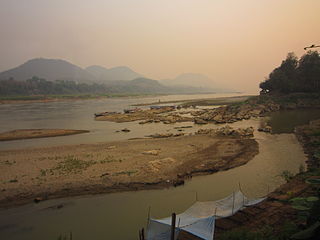
A tributary or affluent is a stream or river that flows into a larger stream or main stem river or a lake. A tributary does not flow directly into a sea or ocean. Tributaries and the main stem river drain the surrounding drainage basin of its surface water and groundwater, leading the water out into an ocean. Irtysh is the chief tributary of the Ob river and is also the longest tributary river in the world. Madeira river is the largest tributary river by volume in the world.

Freshwater is a national park in Queensland, Australia, 34 km north of Brisbane. The park is west of Redcliffe, near Deception Bay, within Caboolture Shire.

A gold rush or gold fever is a discovery of gold—sometimes accompanied by other precious metals and rare-earth minerals—that brings an onrush of miners seeking their fortune. Major gold rushes took place in the 19th century in Australia, New Zealand, Brazil, Canada, South Africa, and the United States, while smaller gold rushes took place elsewhere.

Juncaceae is a family of flowering plants, commonly known as the rush family. It consists of 8 genera and about 464 known species of slow-growing, rhizomatous, herbaceous monocotyledonous plants that may superficially resemble grasses and sedges. They often grow on infertile soils in a wide range of moisture conditions. The best-known and largest genus is Juncus. Most of the Juncus species grow exclusively in wetland habitats. A few rushes, such as Juncus bufonius are annuals, but most are perennials.

A forb or phorb is a herbaceous flowering plant that is not a graminoid. The term is used in biology and in vegetation ecology, especially in relation to grasslands and understory.

Juncus effusus, with the common names common rush or soft rush, is a perennial herbaceous flowering plant species in the family Juncaceae. In North America, the common name soft rush also refers to Juncus interior.

The 2006 United States Senate election in Missouri was held November 7, 2006, to decide who would serve as senator for Missouri between January 3, 2007, and January 3, 2013. The incumbent was Republican Jim Talent. Talent was elected in a special election in 2002 when he narrowly defeated incumbent Democrat Jean Carnahan. Carnahan had been appointed to the Senate seat following the posthumous election of her husband Mel Carnahan, who had died in a plane crash shortly before the 2000 election. Talent's Democratic opponent was Missouri State Auditor Claire McCaskill. Early on the morning of November 8, Talent conceded defeat to McCaskill, having faced considerable political headwinds. Talent lost the election with 47% of the vote, to 49.6% of the vote for McCaskill.
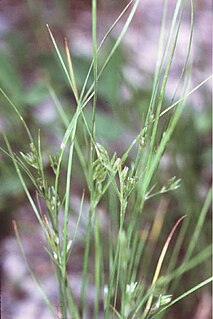
Juncus tenuis, the slender rush, is a clump-forming, round-stemmed perennial in the Juncaceae. Slender rush grows to be between 15 and 60 cm tall. Generally considered a weed, it is rarely sold by retailers as a household container plant. Where it is introduced, it is colloquially called path rush, field rush, slender yard rush, poverty rush or wiregrass.

Juncus articulatus is a flowering plant species in the rush family Juncaceae. It is known by the common name jointleaf rush or jointed rush, which can also refer to J. kraussii from Australia. It is native to Eurasia, Canada, Greenland, and much of the United States. It grows in moist areas, such as wet sand, and thrives in calcareous soils. J. articulatus was found to be more sensitive to drought and salt stress than its congeners J. acutus and J. maritimus. It is a perennial herb producing mainly erect stems from a short rhizome. The stem may root at nodes, and it generally has one or more flattened hollow cylindrical leaves up to 10 centimeters long. Transverse internal partitions or joints may be seen or felt in the leaf of the plant.

Equisetum hyemale is a perennial herbaceous vascular plant in the horsetail family Equisetaceae. It is a native plant throughout the Holarctic Kingdom, found in North America, Europe, and northern Asia.
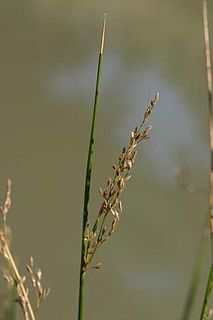
Juncus mexicanus is a species of rush known by the common name Mexican rush. It is native to the southwestern quadrant of the United States and parts of Mexico and Central and South America. It is a plant of moist areas in a great number of habitats, from coast to desert to mountain and low to high elevation.
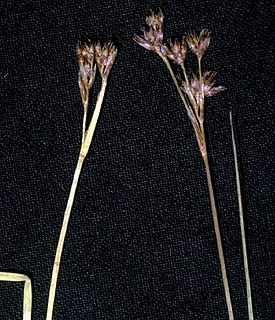
Juncus nevadensis is a species of rush known by the common name Sierra rush. It is native to much of western North America from British Columbia to New Mexico, where it grows in wet areas in many habitat types. This is a rhizomatous perennial herb which varies in appearance. Its thin, smooth stems reach a maximum height between 10 and 70 centimeters. The thin green leaves may be up to 30 centimeters long. The inflorescences generally contain a number of flowers, with each flower bearing dark to very light brown tepals, six stamens with large anthers, and very long stigmas. The fruit is a shiny chestnut brown capsule.

Juncus dubius is a species of rush known by the common name wrinkled rush. It is endemic to California, in the California Coast Ranges, Transverse Ranges, and southern Sierra Nevada. It is a common member of the flora in many wet areas, such as marshes and riverbanks.
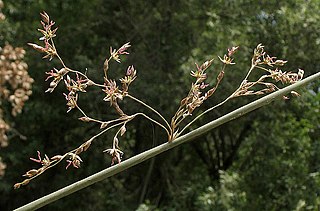
Juncus textilis is a species of rush known by the common name basket rush. It is endemic to California, where it grows along the coast and in the coastal mountain ranges of the southern half of the state.
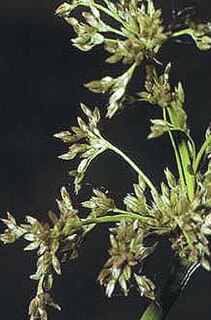
Juncus roemerianus is a species of flowering plant in the rush family known by the common names black rush, needlerush, and black needlerush. It is native to North America, where its main distribution lies along the coastline of the southeastern United States, including the Gulf Coast. It occurs from New Jersey to Texas, with outlying populations in Connecticut, New York, Mexico, and certain Caribbean islands.

Schoenoplectus lacustris, the lakeshore bulrush or common club-rush, is a species of club-rush that grows in fresh water across Europe and some neighbouring areas.



















